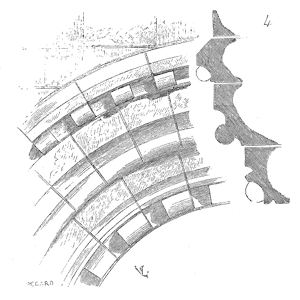Go offline with the Player FM app!
Design for Reliability - Stressors
Manage episode 349634154 series 2359252
Design for Reliability – Stressors
podcast episode with speaker Michael Pfeifer
Any product is a collection of materials that have been engineered, shaped, and modified to become components and joints (e.g., weld and braze joints). The materials can degrade due to exposure to use conditions steel screws corrode when exposed to water, some plastics become brittle when exposed to sunlight, and coatings on surfaces can wear away.
Components and joints will stop functioning as required if their materials degrade too much. This is a problem if it reduces or loses product performance before the end of a product's expected life.
Identifying the conditions to which materials are exposed and selecting materials that can withstand the exposure are critical parts of designing products that have good reliability.
During this event, I will discuss identifying the conditions that can cause materials to degrade.
This Accendo Reliability webinar was originally broadcast on 13 December 2022.
To view the recorded video/audio and PDF slides of the event visit the webinar page.
Additional content that may be of interest
Design for Reliability – Identifying Stressors article
Reliability Testing – Product vs Materials article
Using DFR Tools episode
Where to Start with DfM & DfR with Fred Schenkelberg episode
Why DFR is Essential episode

Reliability and Tolerance Analysis
Tolerance specification communicates the allowance for part variation. Variation happens, and when it is within what we expect, great.

Creating Meaningful Reliability Predictions
Early and often during product development, the team needs to know the expected and meaningful reliability prediction of the current design.

Reliability Integration into the Product Development Process
One of the challenges for reliability engineering in product development is reliability integration into the product development process.

Process Capability, Tolerance, and Reliability
How a focus on variability with process control, process capability and tolerances helps to improve reliability.

Fundamentals of Stress-Strength Analysis
How a focus on variability with process control, process capability and tolerances helps to improve reliability.

Fundamentals of Human Factors
If a person is not able to interact with your product, with or without the manual, they may consider your product a failure.

Using Available Weather Data
How to find and analyze temperature readings over a 10 year period, create histogram and determine how many hours below freezing may exist.

Fundamentals of Tolerance Analysis
There are three approaches to set tolerance limits. Each has ramifications for the eventual manufacturability and reliability performance.

Practical Use of Stress-Strength Models to Develop Specifications
Warranty returns are a great start for setting targets for new products. But how do you translate that to specific numbers to design to?

Fundamentals of Design for Reliability
DFR is more than a set of tools or activities, let's explore the building of a reliability culture that support reliability thinking

Fault Tolerance
Fault tolerant design principles are the best approach to reliability. Or not. It depends on your design challenges.

Helping Products Survive Transportation
Besides building your product inside your customer's facility, your product requires transportation to move your product.

What is Reliability Growth?
This webinar introduces you to the topic of reliability growth (both qualitative and quantitative) along with key concepts
The post Design for Reliability – Stressors appeared first on Accendo Reliability.
188 episodes
Manage episode 349634154 series 2359252
Design for Reliability – Stressors
podcast episode with speaker Michael Pfeifer
Any product is a collection of materials that have been engineered, shaped, and modified to become components and joints (e.g., weld and braze joints). The materials can degrade due to exposure to use conditions steel screws corrode when exposed to water, some plastics become brittle when exposed to sunlight, and coatings on surfaces can wear away.
Components and joints will stop functioning as required if their materials degrade too much. This is a problem if it reduces or loses product performance before the end of a product's expected life.
Identifying the conditions to which materials are exposed and selecting materials that can withstand the exposure are critical parts of designing products that have good reliability.
During this event, I will discuss identifying the conditions that can cause materials to degrade.
This Accendo Reliability webinar was originally broadcast on 13 December 2022.
To view the recorded video/audio and PDF slides of the event visit the webinar page.
Additional content that may be of interest
Design for Reliability – Identifying Stressors article
Reliability Testing – Product vs Materials article
Using DFR Tools episode
Where to Start with DfM & DfR with Fred Schenkelberg episode
Why DFR is Essential episode

Reliability and Tolerance Analysis
Tolerance specification communicates the allowance for part variation. Variation happens, and when it is within what we expect, great.

Creating Meaningful Reliability Predictions
Early and often during product development, the team needs to know the expected and meaningful reliability prediction of the current design.

Reliability Integration into the Product Development Process
One of the challenges for reliability engineering in product development is reliability integration into the product development process.

Process Capability, Tolerance, and Reliability
How a focus on variability with process control, process capability and tolerances helps to improve reliability.

Fundamentals of Stress-Strength Analysis
How a focus on variability with process control, process capability and tolerances helps to improve reliability.

Fundamentals of Human Factors
If a person is not able to interact with your product, with or without the manual, they may consider your product a failure.

Using Available Weather Data
How to find and analyze temperature readings over a 10 year period, create histogram and determine how many hours below freezing may exist.

Fundamentals of Tolerance Analysis
There are three approaches to set tolerance limits. Each has ramifications for the eventual manufacturability and reliability performance.

Practical Use of Stress-Strength Models to Develop Specifications
Warranty returns are a great start for setting targets for new products. But how do you translate that to specific numbers to design to?

Fundamentals of Design for Reliability
DFR is more than a set of tools or activities, let's explore the building of a reliability culture that support reliability thinking

Fault Tolerance
Fault tolerant design principles are the best approach to reliability. Or not. It depends on your design challenges.

Helping Products Survive Transportation
Besides building your product inside your customer's facility, your product requires transportation to move your product.

What is Reliability Growth?
This webinar introduces you to the topic of reliability growth (both qualitative and quantitative) along with key concepts
The post Design for Reliability – Stressors appeared first on Accendo Reliability.
188 episodes
All episodes
×Welcome to Player FM!
Player FM is scanning the web for high-quality podcasts for you to enjoy right now. It's the best podcast app and works on Android, iPhone, and the web. Signup to sync subscriptions across devices.





